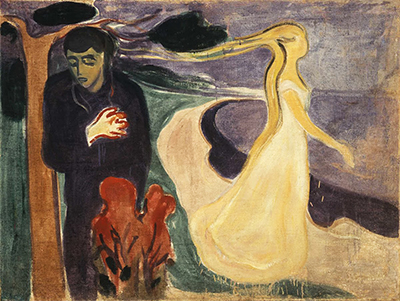Separation from 1896 by Edvard Munch is a practical oil on canvas painting which is one of the top artworks of Edvard munch on different human relations and conditions. The artwork consists of two components, a man and woman whom they appear tied together although the woman is going away.
The blonde young woman appears looking to the sea with her hair flowing out to the man's chest. While the man is moving forward although his way is blocked by a cherry plant that is growing ahead of him. The loving man is dressed in a black colour which also indicates despair and sorrow. He also has a bleeding hand which he uses to grasp his heart. The cherry tree that is growing in front of him appears to be the man’s bleeding heart. The red colour in his heart shows blood, love and pain. At the same time, the red hearted plant shows the artist ideas that he used during his lifeblood drawings.
The woman has flowing arcs that are embraced into an articulated pattern of a flowing shoreline which creates a feminized and fused vision of the past. Separation artwork is beautifully and ornately polished with a theme that is split into two sovereign surfaces. The separation has a diverse and rich texture and surfaces which are both shinny and lusterless. He paints the landscape and human air with gold paint, making it more striking. These surfaces are detached by curving lines which has subtle deviations enthused from Judend style or Art Nouveau. Separation from 1896 resides in The Munch Museum, Oslo in Norway being a Norwegian virtual artist talented in painting.
Edvard Munch was a great inspiration to many artists and artistic movements during his lifetime as a painter. He inspired groups like the expressionism, Fauvism, Surrealism and Symbolism. Artists like Henri Matisse, Max Beckmann, Paul Klee, Ernst Ludwig Kirchner, and Wassily Kandinsky were also inspired by him. Munch started painting at an early age after the death of his mother through his aunt who was a painter. He later went to study at Kristiania's Royal School of Art and Design. Through his career, he met with Frits Thaulow, Christian Krohg, Monet, Goya, Van Gogh and other artists who inspired him. Edvard Munch made 15 artworks in 1896. They include Red-Haired Girl with White Rat, Young Woman on the Beach, Two Human Beings, The Death Bed, Girl on Piano, Self Portrait, Puberty and more.




